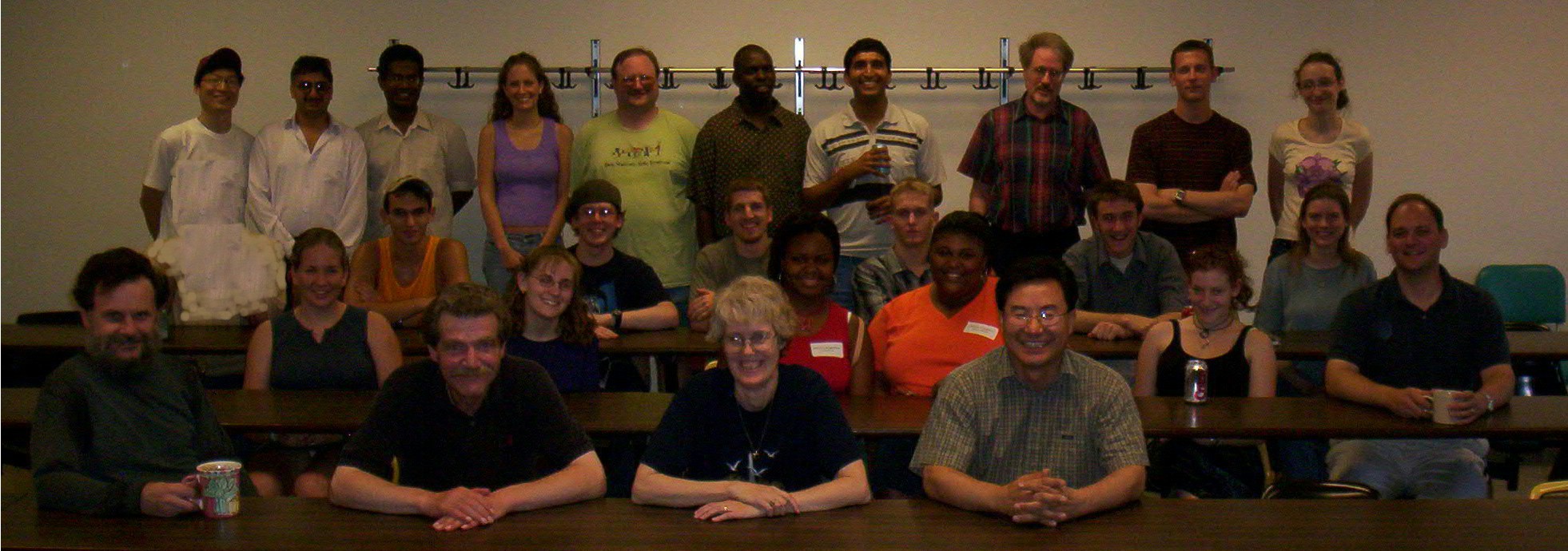Participants
Michael
Anderson
Taylor University
Elizabeth
Blankenship
Iowa State University
John
Bowers
Grinnell College
Denrol
Carayol
Jackson State University
Brian
Davis
Western Oregon University
Laura
Dev
Tufts University
Jacob
Harper
University of Denver
John
Hegeman
Stanford University
Lori
Kraus
The College of New Jersey
Jeff
Langford
Drake Unversity
Sara
Lapan
Univeristy of Chicago
Jessica
Poole
Texas Southern University
Monica
Robinson
Jackson State University
Karyn
Snider
Unversity of Richmond
Misha
Teplitskiy
Rice Unversity
Laura
Walters
Culver-Stockton College
Project
Descriptions
- Polygonal Designs: Existence and Construction Prof.
Sung-Yell Song, Gargi Bhattacharyya, Joohyung Kim, John Hegeman,
Jeff Langford.
Polygonal
designs form a special class of partially balanced incomplete block
designs.
We resolve the existence problem for polygonal designs with various
parameter
sets and find several construction methods with blocks of small sizes. More
details. Paper will
appear in European Journal of Combinatorics. John
Hegeman presented these results at the
Young
Mathematicians Conference 2004 at Ohio State University.
- Frames, Data Communication, and Security
Prof.
Eric Weber, Ghanshyam Bhatt, Lori Kraus, Laura Walters. A
system
using an oversampled Fourier transform for hiding data is given in [J.
R. Miotke and L. Rebollo-Neira, Oversampling of Fourier coefficients
for
hiding messages, Appl. Comput. Harmon. Anal. 16 (2004), no. 3,
203-207.]
When viewed as a cryptographic algorithm, we demonstrate that the
system
is susceptible to a known plaintext attack, therefore providing little
added security when used to hide messages. Paper
appeared in Journal of
Mathematical Analysis and Applications.
Lori Kraus presented these results at the Young Mathematicians
Conference
2004 at Ohio State University. Laura Walters presented this work
at Argonne Lab's Undergraduate Research Symposium in November 2004.
- Partial Semigroups and Primality Indicators in
the
Fractal
Generation of Binomial Coefficients to a Prime Square Modulus Prof.
Jonathan D. H. Smith, Benard Kivunge, Jessica Poole, Misha
Teplitskiy.
This project builds on the work of the summer 2003
group and examines the congruence classes of binomial
coefficients
to a prime square modulus as given by a fractal generation process for
lattice path counts. The process depends on the isomorphism of partial
semigroup structures associated with each iteration. We also consider
integrality
properties of certain critical coefficients that arise in the
generation
process. Generalizing the application of these coefficients to
arbitrary
arguments, instead of just to the prime arguments appearing in their
original
function, it transpires that integrality of the coefficients is
indicative
of the primality of the argument. Paper (joint
with 2003 group) submitted. Misha Teplitskiy presented these
results
at the Young Mathematicians Conference 2004 at Ohio State
University.
Matlab codes IteratedMatrixModp2.m,
LambdaPrimalityTest.m, TriangleGeneratorModN.m.
- The Fischer Matrix Completion Problem Prof.
Leslie Hogben , Amy Wangsness, John Bowers, Karyn Snider. A partial
matrix is a matrix in which some entries are specified and others are
not.
A completion of a partial matrix is a matrix obtained by choosing
values
for the unspecified entries. A matrix completion problem for the
class of matrices X asks: Does a partial X-matrix have a completion to
an X-matrix? Applications arise in situations where only
partial
data are known or available. Examples include seismic
reconstruction
problems and image enhancement, data transmission and coding
problem.
A Fischer matrix is a P-matrix that satisfies Fischer's inequality for
all principal submatrices. A pattern of positions in an n x n real
matrix
is said to have Fischer completion if every partial Fischer matrix
which
specifies that pattern can be completed to a Fischer matrix. All
patterns
of entries of size up through 4, along with symmetric patterns up
through
size 5, are classified as to whether or not they have Fischer
completion. Paper (joint with 2003 group)
appeared in Linear
Algebra and Its Applications.
- Modeling Cancer Mathematically Prof.
Howard Levine, Laura Dev, Sara Lapan. The purpose of this
project
was to create a mathematical model of tumor angiogenesis. This
model
analyzes the effects of cell density and the concentrations of
fibronectin,
a protease enzyme, growth factor, and various inhibitors on the
movement
of endothelial cells along the capillary wall. We used
enzyme
kinetics, random walks, and systems of differential equations to derive
mathematical relationships among the above 5 components. From
these
equations and the help of MATLAB, we were able to simulate the onset of
angiogenesis and show that certain systems are inherently unstable,
while
others can be controlled by the presence of certain inhibiting
factors.
Laura Dev and Sara Lapan presented thse results at the Young
Mathematicians
Conference 2004 at Ohio State University
- Dynamical Systems
Prof.
Justin R. Peters, Prof. Wolfgang
Kliemann
, Ajith Gunaratne, Rajeev Rajaram, Michael Anderson, Denrol
Carayol.
We look at various ways of mapping one linear differential system onto
another. In R^d one can create a C^k conjugacy (with k >= 1) that
preserves
the entire Jordan structure except with eigenvalues that are multiples
of each other, while a C^0 conjugacy only preserves the dimensions of
the
unstable and stable eigenspaces. In an attempt to find a result in
between
these two, we project dynamical systems form R^d onto a projective
space
P^d
- Evolutionary Robotics Prof.
Dan Ashlock, Eun-Youn Kim, Elizabeth Blankenship, Brian
Davis, Jacob
Harper.
Grid robots, virtual robots living on a rectilinear grid, are capableof
performing a wide range of tasks. These tasks vary widely in difficulty
and complexity in an unintuitive fashion. This study seeks to find
generic
improvements in the performance of grid robots by comparing two
representations,
GP-Automata and ISAc lists, on several different tasks. These include a
multi-agent version of the Tartarus task, the builder task, a version
of
the game tag, and the follower task. In addition to testing these two
representations
on all four tasks we assess the worth of a generic technique called
genetic
hybridization. This technique is inspired by techniques used in stock
breeding
and should not be confused with algorithmic hybridization in which
evolutionary
algorithm techniques are blended with non-evolutionary techniques.
Overall
the ISAc list representation is found to be superior for the grid robot
tasks studied. Genetic hybridization is found to improve
performance
for all the tasks studied.


